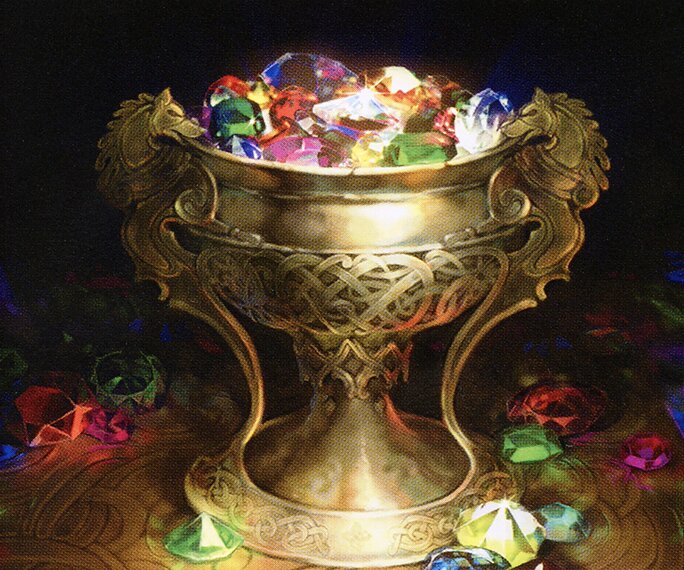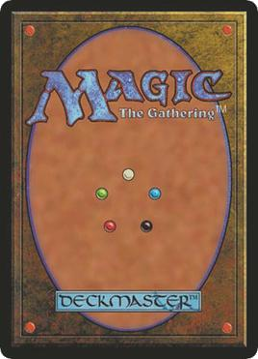 Art by Olena Richards
Art by Olena RichardsWelcome to my cube!
I've been maintaining this cube for about a decade now. The project started from the simple desire to play more games of limited: booster drafting at one of our FLGS's was too expensive and time-consuming to do regularly, and my friends that were into Magic weren't that into it, so doing our own drafts was out of the question. Making a cube seemed like a logical compromise. I was especially drawn to the idea of the pauper cube - using only commons would keep the costs down (well, it was supposed to anyway...), and the individual card complexity was low enough to make it accessible to newer players.
Originally the cube was just a bunch of bulk foils tossed in a cardboard box, with little consideration to balance, theme, or synergy. Over the years I have slowly made adjustments and corrections, and have tuned the experience to a place where I'm happy with it. The main objective is to follow a straightforward, lenticular design philosophy, inspired by many of MaRo's own: by ensuring that each slice of the colour pie has its own distinct flavour while also including some less obvious combos and synergies across the cube, you make the experience enjoyable for players of all skill levels.
Finding a method to track the cube was actually my wife's idea, mostly because she was frustrated with how many duplicate cards I kept buying by accident. Not only has this been an invaluable tool to help fine-tune which cards make the cut, but it also serves as a nice introduction for the folks we draft with! So, without further ado, here is a (not so) short summary of what to expect when drafting with us!

 White
White 

White is easily the most diverse and inclusive colour of the bunch. On one end you have decks that are hyper-aggressive, with a host of "weenies" and support spells, with the other end of the spectrum representing pure control with lifegain, removal, and a solid defensive line of creatures. While this might sound like a weakness, this flexibility is actually one of white's biggest strengths, and it makes for a great second colour when you're lacking direction. Just because you want to win doesn't mean you can't play nice with others too, does it?
Hallmark White Cards

 Blue
Blue 

You know how most toddlers go through that phase where they vehemently say "No!" to everything? Make your opponent go through that kind of misery when they sit across the table from your blue deck! Your creatures aren't the mightiest, but who cares when you can counter, bounce, tap, and draw to your heart's content. You aren't all bark though - if left unchecked your creatures will fly right over your opponent's and steal the game faster than you can say "in response..."!
Hallmark Blue Cards

 Black
Black 

Bring on the Hot Topic and eyeliner - black is all about fear, pain, and the overwhelming inexorability of the death of everything. Your creatures aren't the strongest but they come with nasty side effects, and it hardly matters if you've killed your opponent's best creatures. Sure, some of your cards may hurt you a little, but it's a small price to pay for victory, isn't it? Now, if you'll just sign here...
Hallmark Black Cards

 Red
Red 

MATH IS FOR BLOCKERS AND THINKING IS FOR THOSE FRIGGIN' NERDS WHO PLAY BLUE! IT'S CALLED THE RED ZONE FOR A REASON - SLAM SOME BADA$$ CREATURES ON THE TABLE AND KEEP TURNIN' THEM SIDEWAYS UNTIL YOUR OPPONENT BEGS FOR MERCY! OR THROW SOME FIREBALLS AT 'EM; EVERYONE LOVES EXPLOSIONS! YOU MIGHT CRASH AND BURN IN A FINAL BLAZE OF GLORY, OR YOU MIGHT REDUCE YOUR OPPONENT'S KINGDOM TO ASHES - EITHER WAY IT'S GONNA BE AWESOME!
Hallmark Red Cards

 Green
Green 

If you're the kind of person who rooted for the bear in The Revenant then green is for you! Stop shaving for a while and pull out some beef jerky, because it's time to go wild! You may not have the fancy tricks or removal spells of the other colours, but who cares? It's the survival of the fittest and your creatures really are the fittest, plus you have the mana ramp to summon them ahead of schedule too.
Hallmark Green Cards

 Colourless
Colourless 

The main objective for colourless cards is to fill gaps and help consistency by offering generic effects like ramp, fixing, life gain, card draw, and aggressive creatures. You're paying a bit of a mana tax over premium coloured cards, but beggars can't be choosers.
Hallmark Colourless Cards

 White/Blue:
White/Blue: 

Blue-white looks to leverage a combination of powerful control cards and creatures with enters-the-battlefield abilities to bury the opponent with value and card advantage. Your creatures are on the weaker side but their abilities, flying especially, can take them over the top.
Typical archetypes: Control, Midrange, "Combo"
Azorius Staples

 White/Black:
White/Black: 

White-black epitomizes the belief that the best offence is a good defence. You're looking to play the long game - gaining lots of extra life, removing your opponent's best threats, and slowly picking away at their life total.
Typical Archetypes: Control, "Combo"
Orzhov Staples

 Blue/Black:
Blue/Black: 

The poster child for control decks, blue-black decks are loaded with removal, counterspells, card draw, and blockers. Maybe you'll win with a few fliers, maybe a big finisher or two, or maybe your opponent will just concede.
Typical Archetypes: Control
Dimir Staples

 Blue/Red:
Blue/Red: 

The closest thing the cube has to a combo deck, blue-red is all about slinging spells. You have a ton of options for tuning your deck to be more aggressive or controlling, and the potential to deal massive damage out of nowhere.
Typical Archetypes: "Combo", Control, Midrange
Izzet Staples

 Black/Red
Black/Red 

Black-red is all about playing the attrition game: you have access to more removal than any other colour combination, and a number of options for dealing consistent chip damage. You can get aggressive out of the gate and sneak in the last few points of damage, or you can go ham on removal and play the long and slow game.
Typical Archetypes: Aggro, Midrange, Control
Rakdos Staples

 Black/Green
Black/Green 

If you hate the feeling you get when your opponent uses a removal spell on your big bomb creature, black-green just might be the colour combo for you: kill spells and efficient creatures combine with graveyard recursion to make for a very reliable package. Or you can always try and mill or discard a giant monster and reanimate it instead, whatever makes you happy.
Typical Archetypes: Midrange, "Combo"
Golgari Staples

 Red/Green
Red/Green 

Red-green proves that sometimes simple is better: play some beaters, use removal on blockers, and turn your guys sideways. You have access to many of the best creatures, but if they can't go the distance you can always use your burn spells on the opponent's face instead - hopefully they brought sunscreen!
Typical Archetypes: Aggro, Midrange
Gruul Staples

 Red/White
Red/White 

Small but mighty, white-red is looking to go all-in with a critical mass of small creatures, winning the game before the opponent even realizes it started. Tap or burn their best blockers out of the way, sneak in the last few points with evasive creatures, and get home in time for dinner.
Typical Archetypes: Aggro
Boros Staples

 Green/White
Green/White 

White-green is also good at going wide, but their real strength is in synergy: with the support from auras and +1/+1 counters your deck truly will be more than the sum of its parts. If you'd rather keep it simple that's fine too - your creatures are great all across the mana curve, so you'll have access to relevant plays for every stage of the game.
Typical Archetypes: Aggro, Midrange, "Combo"
Selesnya Staples

 Green/Blue
Green/Blue 

If you want to keep your opponent on the back foot and direct the flow of the game look no further than blue-green. You have access to a flexible suite of options and tricks to control the game's tempo, and make up for a lack of removal with some of the nastiest beasts in the air and on the ground.
Typical Archetypes: Midrange
Simic Staples
P.S. - some particularly keen Pauper cube fans may notice the omission of a few iconic cards. I have, for various reasons, implemented a few additional restrictions on what cards can go into the cube:
- Only cards which have been printed in paper with a common, or promo, set symbol (so no Battle Screech)
- Only cards which are available in foil (so no Evincar's Justice)
- No hybrid cards or cards with off-colour activation (so no Momentary Blink - Fire/Ice is the exception, and a strong bend)
- Basking Broodscale
- Eldrazi Repurposer
- Geyser Drake
- Molten Gatekeeper
- Patient Naturalist
- Aerie Auxiliary
- Corrupted Shapeshifter
- Loan Shark
- Scurrilous Sentry
- Lava Spike
- Highway Robbery
- Mandibular Kite
- Lotus Petal
- Bone Shards
- Drossclaw
- Lush Oasis
- Sacred Peaks
- Abraded Bluffs
- Festering Gulch
- Eroded Canyon
- Forlorn Flats
- Faithful Watchdog
- Creosote Heath
- Bristling Backwoods
- Jagged Barrens
- Soured Springs
- Lonely Arroyo

